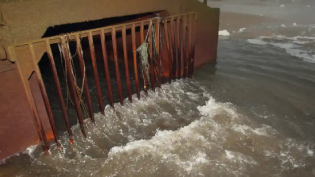Overflow Map
New Map Features
Rainfall Data and Bathing Water Locations are now available
Overflow Map FAQs
The map shows all Scottish Water monitored overflows that can show data in near real-time.
It also includes some monitored overflows that cannot currently show data in near-real time on the map.
Some parts of the system are operated on our behalf by Private Finance Initiative (PFI) companies. Scottish Water does not publish this information.
The map does not show unmonitored overflows at this time.
Not all overflows are Combined Sewer Overflows (CSOs). There are three types of overflow:
- Combined Sewer Overflows (CSOs), which stop the system from becoming overwhelmed during heavy rainfall
- Settled Storm Sewage Overflows (SSSOs), a form of CSO that provides a level of treatment or settlement before discharge
- Emergency Overflows (EOs), which should only operate in the event of sewer system failure and should not operate in response to rainfall
The overflow map shows all Scottish Water monitored overflows for which we can publish data in near real-time, and some which cannot currently show data in near real-time.
There are more than 1,400 monitored overflows currently included on the map and this will continue to increase over time.
The current total number of locations shown is available by removing all filters and selecting the List View option.
As we continue our review/verification processes and monitor installation programme, we will look to show data for further monitored overflows in future.
The map does not currently show unmonitored overflows.
'Near real-time' data means the information available in the last 48 hours which indicates overflow status and the duration of an overflow event during this time.
The map is updated every 60 minutes based on available information and the last time the map was updated is included top right above the map.
However, not all overflows record or send data at the same frequency so we have included the last date and time the data was updated in the information for each overflow location.
Previously, monitors were generally installed to meet licence requirements and for reporting on an annual basis. This means, how often data is recorded and received from these monitors can vary. The near real-time status and overflow events published on the map are based on the data available.
The map, and associated data, don't advise if it's safe to swim or enter the water. Overflows are just one of several sources that could impact the water quality and safety of waterbodies, and these can vary depending on the surrounding area.
For the latest information on bathing water quality visit: Bathing Waters | Home | Scottish Environment Protection Agency (SEPA)
The map will only indicate if a monitor has been activated and an overflow event may have occurred. Planned investment priority information is included.
Here are just some of the factors that could have an impact on water quality:
- Agricultural run-off from farmland
- Discharges from private systems such as septic tanks and overflows
- Road runoff from surrounding roads and highway drainage systems
- Waste pipes from houses wrongly connected to surface water sewers or culverts
- Domestic animal waste, such as dogs, farming livestock, wild animals, and birds
- Human behaviour, due to items wrongly disposed of down sinks and toilets
Further information is available at:
River basin management planning | Scottish Environment Protection Agency (SEPA)
Bathing waters are officially designated by the Scottish Government. They will be displayed by selecting the bathing water icon on the top left of the map. A purple dot will indicate their location, which becomes a swimmer icon when zooming in. As you zoom in further, the icon changes to a shaded area representing the boundary of the designated bathing water area with the name labelled.
You can also search for a designated bathing water by name. For example, if you search for "Ayr," the drop-down list and List View will include "Ayr (South Beach) - Bathing Water" and “Heads of Ayr – Bathing Water”
The location of monitored overflows within 2km of the bathing water boundary will be shown.
It’s important to note the overflow status indicates when an event duration monitor (EDM) has been activated and an overflow event may have occurred. It does not confirm an overflow event. This information does not reflect potential risk or impact on bathing waters.
Designated bathing waters are monitored and classified by Scottish Environment Protection Agency (SEPA). You can find more information at SEPA - Bathing Waters
The map, icons and associated data do not advise whether it's safe to swim or enter the water.
Overflows are just one of several sources that could impact water quality, and these can vary depending upon the surrounding area and nearby land use. Other sources could include run-off from farms or urban areas, private septic tanks or animal waste, livestock, wild animals and birds.
Visit our general Overflow FAQs page for more information.
The map will only indicate that a monitor has been activated and an overflow event may have occurred. It does not confirm an overflow event.
For the latest information on bathing water quality visit: SEPA - Bathing Waters
We have included rainfall data following feedback from customers and stakeholders who felt this would be useful to them, along with the data from overflow monitors.
Overflows are designed to operate automatically as a safety valve during or directly following heavy rainfall and storm events. Rainfall data will help to show if an overflow is operating as it should.
Some overflows cover large areas, so it may take several days after heavy rainfall, for rainwater to reach the river or sea.
The addition of rainfall data helps our response to any potential sewer system issues, such as electrical, mechanical, power failure, and/or blockages. If the data is showing an overflow is operating during dry spells, this may indicate there is an issue and we’ll investigate this as soon as possible.
Rainfall data is provided by selecting the Cloud/Rainfall icon on the map. You will be able to see a visual representation of rainfall over the past 48 hours, much like you’d see on a live weather map on your TV news. You can use the slider to view where the rainfall has travelled over the previous 48 hours.
Once the rainfall icon has been selected, a colour guide will display to indicate the levels of rainfall on the map.
Some overflows cover large areas, so it may take several days after heavy rainfall, for rainwater to reach the river or sea.
The visual data on the map and the data on the overflow cards need to come from two different data sources. As a result, occasional differences occur, such as Shetland, where it may show visually there has been rainfall using the 48 hour display on the map, but the information card for the overflow location shows no rainfall data.
The map uses clustering to avoid being overwhelmed with information. To make it easier for users, monitor locations are clustered around a central point using a blue circular icon, with the number of monitor locations displayed.
To see individual locations, users should select the circle icon, which will zoom in to show the separate colour-coded icons so you can choose which location to view.
A double water drop icon indicates there are multiple overflows at the same location. Once this icon is selected, the individual overflows will be displayed, and you can choose the details you wish to view.
The numbers indicate all monitored overflows within that geographical area. To see individual locations, users should select the circle icon which will zoom in to show the separate colour-coded water drop map points icons so you can choose which location to view.
If there is no data available for an overflow on the map, there are three main reasons for this. These are:
No Data Available - marked with a grey water drop icon
- The monitor has communications issues which means we are not currently receiving data from the monitor
- The monitor may be providing unreliable data and needs to be investigated
- The monitor may currently only send data when there is an overflow event
Under Maintenance – marked with a grey water drop and spanner
- The monitor may be faulty or damaged and needs to be repaired. We will be aware of this and repairs will be underway as soon as possible
- The monitor data quality needs to be investigated
- The monitor is undergoing planned maintenance
Not Available in Near Real-time – marked with a clock and strikethrough
- Although this location is monitored, data is not currently available in the near real-time overflow map. We hope to bring this location online in future.
Annual reported data is currently available via our Published Overflow Data.
An overflow may be removed temporarily from the map if the data availability or data accuracy needs to be investigated, or investigations have been undertaken and there are issues that need to be addressed.
Once investigations are complete and any issues have been resolved the overflow will be added back to the map.
The map currently shows:
- all Event Duration Monitor (EDM) overflows for which we can report data in near real-time.
- other monitored overflows which cannot display near real-time data on the map, but some are included in our annual published data.
We will continue to review the information available and may update this in the future.
If an overflow has a Planned Investment Priority of ‘None’, either studies have indicated that no improvement was required or the need for a study has not yet been agreed and the overflow has not been assessed.
Where required, studies have been undertaken to prioritise unsatisfactory sewer overflows for phased improvement, further information on investment prioritisation can be found at Prioritisation of Sewer Overflows in Scotland. Where studies confirm there is a need for improvement, we will agree priorities with our environmental regulator, the Scottish Environment Protection Agency (SEPA).
The need for studies is agreed with SEPA and is based on receiving water classification information. The River Basin Management Plan (RBMP) for Scotland 2021 - 2027.
Event Duration Monitors (EDMs) only provide the start and stop times, and duration of overflows. Data does not include volume
In some cases, we are required to report volume or an estimated volume, which is why this is included in the published reported data.
Other monitored overflows have more limited data and this doesn’t include volume.
Event Duration Monitor (EDM) data doesn’t confirm an overflow event, it only indicates there is, or has been, a potential overflow event. For example, the monitors can be very sensitive and can be set off by simple vegetation movement, or even a spider moving in its web!
Those overflows that have no data available in near-real time or are under maintenance, will not show any data.
We aim to provide the most accurate and up-to-date information possible. We update the map as new data comes in. If there’s a delay in the data sent from a site, it might show as overflowing for longer than it did. Once we receive new data, the duration is corrected.
Overflow FAQs
If you would like to know more about overflows and how they work, you can find more commonly asked questions on the link below.
More InfoOverflow Map Data API
An Application Programme Interface (API) is available below to integrate our overflow map data into your application.
API Guidance







